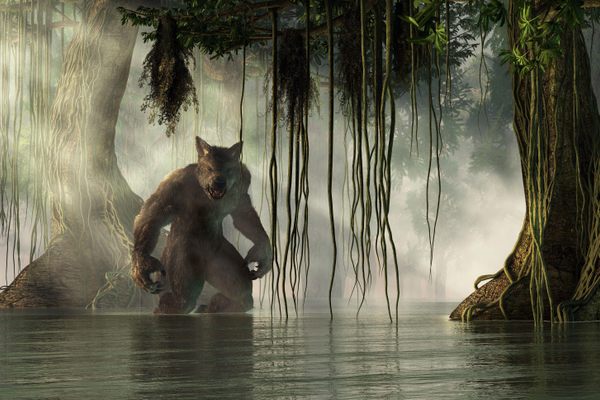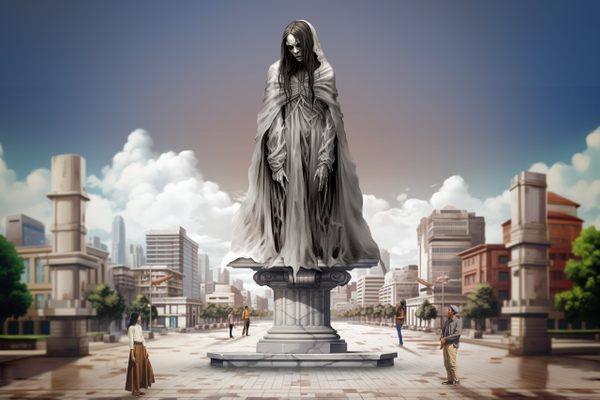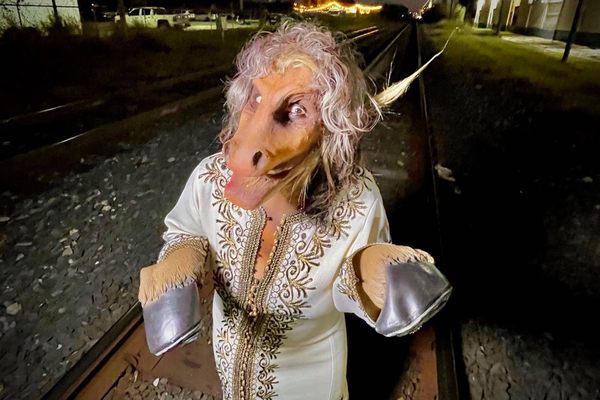
The Strange, Awful Truth Behind Utah’s Eerie Stone Cross
It’s more bizarre than the urban legends.
For decades a crudely constructed, 20-foot-tall cement and stone cross stood in a hollow on the northern outskirts of Kaysville, Utah. Marked with a large letter K in the center, the cross was known to locals as Kay’s Cross. It couldn’t be seen from any road and was on private property, undeveloped except for a few footpaths that meandered deep into the woods. Its secluded location, unknown origins, and proximity to the Kaysville Cemetery made Kay’s Cross a fixture of urban legend.
Those who had actually seen Kay’s Cross said it was built by a polygamist who murdered his seven wives and buried them around its base before hanging himself from a nearby tree. In another version of the story, one of the wives’ hearts was entombed in the cross. Some reported seeing the bones of small animals scattered at its base, and stories of ghosts, witches, werewolves, and ritual sacrifices swirled into the rumors depending on who was telling the tale. Even those who scoffed at the supernatural elements agreed that if the property’s reclusive owners caught you trespassing, they’d blast you with a shotgun full of rock salt.
The thrill and risk of visiting Kay’s Cross at night—particularly during a full moon, when it was said the cross glowed and would burn you if you touched it—had scores of parents warning their children to stay away from the ominous monument and lured generations of teenagers into the hollow.
Linda Arnell, who grew up in Kaysville and still lives just one town over, first hiked to the cross in the 1960s with a group of her fellow fifth graders. “I was shocked the first time I saw it because it was so large,” she remembers. “The horizontal part of it was the size of a casket. We thought for sure there were bodies in the cross.”
Keith Elison, who also grew up in Kaysville, went in the 1980s when he attended Morgan Elementary School, which had a playground bordering the hollow. “During recess, we snuck under the fence and hiked through the woods,” he admits. When they came to the clearing and saw the enormous cross, Elison says, “I immediately got that ‘uh-oh’ feeling and felt like I had crossed some kind of line in my life.”
Roger Gardiner’s childhood home bordered the property, and he could have walked from his front door to the base of the cross in under five minutes. But he never once visited it because he remembered his dad telling him and his brothers, “Only go to Kay’s Cross if you want big trouble.”
Indeed, many of the locals said Kay’s Cross was surrounded by an otherworldly evil—or at the very least it was a magnet for sketchy and unpredictable people. More than a few teenagers bragged about hiking to the cross at night, getting drunk or stoned, and spray-painting pentagrams on the rocks. The pious and prudent kept their distance, and the adventurous and reckless weren’t always reliable with their stories. In the pre-internet age, no digital photographs of the cross could be snapped and posted, so legends of it easily grew more mysterious.
One documented fact that locals could agree on, however, was the cross’s widely reported destruction. On February 15, 1992, nearby residents reported hearing a loud boom. Deputies of the Kaysville police department made their way into the hollow to find Kay’s Cross destroyed, apparently by 80 pounds of dynamite planted at the base; no arrests were ever made. Locals speculated the reclusive property owners destroyed it themselves because trespassers had become such a nuisance.

In the years that followed, the foot traffic into the hollow waned, but the urban legends were too sticky to let go. Brent Hugh, who grew up in Kaysville, took up Kay’s Cross lore as a hobby, researching it and publishing his findings on his blog. Some of what Hugh discovered was a matter of public record but had been obscured or forgotten, taking a backseat to the more fantastical stories of witches and animal sacrifice.
The land Kay’s Cross stood on was—and still is—owned by the Kingston clan. The Kingstons were originally a group of Mormon fundamentalists who broke from the mainstream Church of Jesus Christ of Latter-day Saints in the 1920s. The clan’s patriarch, Charles Elden Kingston, founded what his followers called “the Order,” and sometimes “the Co-Op”; in public records it is the Davis County Cooperative Society. The Co-Op practiced polygamy and lived under a “United Order,” a type of communism where goods and services would be shared. Over the decades, they became increasingly withdrawn from society. But the clan’s entrepreneurial self-reliance led them to acquire multiple farms, a cattle ranch, and even a coal mine. And their beliefs and practices have often pulled them out of obscurity as shown most recently in a September 2022 lawsuit filed by former clan members against the Kingstons for sexual battery, child abuse, and sex trafficking minors born into the organization.
“They’re a pretty large and wealthy and secretive group,” Hugh explains. “They very much keep to themselves.” Hugh found property records and newspaper articles on the Kingstons but very little information about the enormous cross that stood on their property. Then in 2019, Hugh received an email from someone claiming that her father, Malvern Hansen, had helped build the cross in the 1940s. Hugh was told Hansen had written about it in his journal, and was given sections of it for publication.
If Hansen’s story is true, the origins of Kay’s Cross are far less sinister than murdered wives and ritual sacrifice. The real story, however, may be even more bizarre, involving the Kingston clan and a wandering religious zealot who claimed to be the reincarnation of Jesus Christ.
In his journal, Hansen recorded that in the summer of 1946, he and other members of the Kingston’s Co-Op met with a man named Francis Pencovic, a messianic figure who went by the name Krishna Venta and believed himself to be Jesus Christ. Pencovic had begun preaching his gospel while stationed in the Army at Salt Lake’s Fort Douglas in 1945. His enlistment records describe him as a “self-employed lecturer, teacher and writer of Philosophy [sic].”
Pencovic served in the Army with John Ortell Kingston and was invited to preach to the Kingstons by the clan’s patriarch. After a few meetings, Hansen and Charles Kingston confided to each other that they didn’t really believe Pencovic was the son of God. Despite this skepticism, Pencovic persuaded members of the clan to build a stone cross on their property as a tribute to Jesus’s crucifixion.

Hansen wrote that the K on the cross stood not for Krishna, Kaysville, or even Kingston but for “knowledge.” Unlike a standard crucifix, the base, arms, and head spread away from the center junction. Grooves were made in the arms to serve as shelves for tomes of scripture which would then be covered by stained glass doors. But Hansen records that Pencovic moved on to California later that year while the cross was still under construction. In Pencovic’s absence the project was abandoned, although Pencovic apparently continued to use the stylized cross in the new organization he founded, WKFL—Wisdom, Knowledge, Faith, and Love. “When you look at old photos of [Pencovic]’s compound in California, it was his symbol,” says Hughs. “That same motif was on the clothing, even the doors.”
Hansen’s journal entry is corroborated by a little-heralded newspaper article. Shortly after Kay’s Cross was destroyed in 1992, the Deseret News reported that a man named Merlin Kingston reached out to the Kaysville-Layton Historical Society claiming to have information on the cross and wanted to “set the record straight.” Merlin Kingston is named in Hansen’s journal as one of the builders of Kay’s Cross. Sections of his testimony leaked to the Deseret News at the time describe Pencovic’s involvement. But the article was thin on details. The interview was supposedly recorded, but Roselyn Slade, a society member who heard Kingston’s story firsthand, told the Deseret News, “He gave us the information with the understanding we wouldn’t talk about it.” (The historical society has since dissolved and records of Kingston’s testimony have been lost.)
About the time Malvern Hansen’s daughter reached out to Hugh, she also contacted Kristina Murdock of the Kaysville-Fruit Heights Museum of History & Art. “She said he wanted to put the real story out there but didn’t want people to make it all creepy,” says Murdock, who herself remembers visiting the cross as a kid—but only in the daylight. At age 96, Hansen shared his journal entry with Murdock as well as a copy of Pencovic’s original blueprint of the cross. He confirmed the cross was Pencovic’s idea. When asked why the architect of the cross had been kept so secret, Hansen replied, “It was not kept secret. We just didn’t talk about it as we had other things to do.”
Hugh speculates the reason it took Hansen and Kingston so long to share their story was for fear they’d publicly put their group in an unfavorable light. “[Pencovic] must have made quite an impression on the top leaders,” says Hugh, but “they’re so secretive that people outside the group, and probably even people inside the clan had no idea about the history of the cross. There might have even been some embarrassment about it.”
A decade after he left Kaysville, Pencovic was murdered in a suicide bombing by two of his WKFL followers who believed he had embezzled from the organization and committed adultery with their wives. Nine others also died in the explosion, which may have been the genesis of the legend about the nine murdered wives buried at Kay’s Cross.
Today, the remains of the enormous cross are still visible. The base has become a pile of cement and creek rock that can be shrouded by vegetation in the summer. Railroad ties that were used to frame the cross (and which Hansen described in his journal) are exposed now, though twisted and bent from the explosion. The arms remain intact, and the large letter K in the center of the shattered cross can still be seen.
About a decade after Kay’s Cross was destroyed, members of the Kingston clan decided to open the land to the paying public for a “haunted” tour of the hollow. A scale replica of the old cross was built closer to the main road, and paths into the hollow became an outdoor haunted walk. The tour’s website leans heavily into the old urban legends. A video on the site uses ominous music and images with a sinister voice that calls the cross “a beacon of evil” and warns that “numerous sightings of paranormal activity have plagued these woods for generations.” (Members of the Kingston clan did not return requests for interviews.)
“Forty years ago, they never would have done anything like that,” says Hugh. “They just didn’t want to mix with society. But now they’ve turned what used to be a thorn in their side into a source of income.”
“The funny thing is if we’d known the real story, we probably wouldn’t have been interested in it at all,” says Keith Elison of his childhood fascination with the cross. “To us, it was this terrifying monument of evil with all these mysteries surrounding it. We had to see it for ourselves. But if we’d known some guy who thought he was Jesus tricked some polygamists into building it, we probably would have just stayed on school grounds and played tag.”

















Follow us on Twitter to get the latest on the world's hidden wonders.
Like us on Facebook to get the latest on the world's hidden wonders.
Follow us on Twitter Like us on Facebook